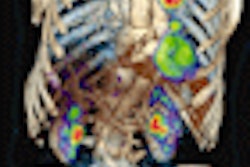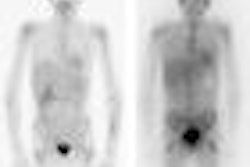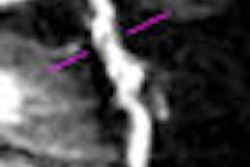After seven years of research and lobbying, the Ontario government has agreed to public funding for PET imaging beginning in October, joining six other Canadian provinces that already have PET programs.
Under the Ontario Health Insurance Plan, patients will be covered for seven cancer indications: solitary pulmonary nodule cancer, thyroid cancer, germ cell tumors, colorectal cancer, lymphoma, clinical stage III non-small cell lung cancer, and limited-disease small cell lung cancer.
Cardiac PET scans also will be reimbursed for myocardial viability assessment and prior myocardial viability or stress imaging assessment with another modality, such as SPECT using thallium or dobutamine stress echocardiography.
|
PET indications with reimbursement in Ontario
Source: Ontario Medical Association Section on Nuclear Medicine and the Ministry of Health and Long-Term Care Ontario. |
PET coverage will be available for 10 PET scanners in eight centers located in Ottawa, London, Toronto, Hamilton, and Thunder Bay.
OCOG research
Over the past seven years, PET exams were funded as part of a clinical research trial conducted by the Ontario Clinical Oncology Group (OCOG). The entity is akin to the National Oncologic PET Registry (NOPR) in the U.S., though the Canadian trial was not as extensive as the NOPR.
"Eventually, enough information was obtained to allow the government to have a greater degree of confidence to move forward with publicly funded PET," said Dr. Christopher O'Brien, president of the Ontario Association of Nuclear Medicine (OANM) and medical director of nuclear medicine at Brantford General Hospital in Ontario. "The flood gates are not open, but it is a step in the right direction."
The Ontario government also plans to allocate funds to each PET center in the province to scan a certain number of patients per year. Total funding is still under consideration by the Health Ministry.
Reimbursement fees
The proposed professional component is $200 ($182 U.S.) for a physician to interpret a PET/CT image. The CT scan is not used for diagnostic purposes, but rather for attenuation correction and image localization. If there is a diagnostic CT scan required, it will be sent to radiology and billed separately.
"The assumption is that most of these individuals would have had a diagnostic CT scan around the same time as the PET scan," O'Brien said, "so they don't anticipate many diagnostic CT scans done at the same time as the PET/CT."
The operational fee is expected be approximately $725 ($660 U.S.), along with approximately $600 ($546 U.S.) for the radiopharmaceutical FDG. The total for a whole-body oncologic PET scan would be about $1,525 ($1,387 U.S.).
In Canada, each province establishes its own fee schedule for imaging reimbursements. Professional fees range from $200 to $280 ($182 to $254 U.S.) across the country. Operational costs are covered by each imaging center receiving a certain number of dollars to do a certain number of procedures, which is similar to how Canada funds MRI scans.
Quebec has the largest PET installation base and the most active funding mechanism for approximately 21,000 patients per year. By comparison, Ontario will have funding for approximately 2,600 oncology patients and 1,720 cardiology patients for the whole year for the entire province.
Supply and demand
A budget allocation for 4,300 PET patients, however, appears to fall far short of potential demand. In 2001, the Institute for Clinical Evaluative Sciences (ICES), which serves as the health technology assessment arm of the Ontario government, estimated that approximately 24,000 patients in the province would benefit from PET scans.
"Ontario still has the most restricted access to PET in Canada," O'Brien added, "but at least it is a step in the right direction."
Currently, there are PET centers in British Columbia, Alberta, Manitoba, Quebec, New Brunswick, and Nova Scotia. The provinces of Saskatchewan, Newfoundland, and Prince Edward Island have no PET centers, although Newfoundland and Saskatchewan have been authorized to move forward with a PET program. Because of its sparse population, Prince Edward Island is expected to send its PET patients to New Brunswick for scans.
Molybdenum-99 shortage
As is the case in the U.S., Canadian nuclear medicine proponents are dealing with the global shortage of the medical isotope molybdenum-99 (Mo-99), as Atomic Energy of Canada (AECL) continues to repair its Chalk River, Ontario, nuclear reactor. Last week, AECL projected that the facility will be offline until early 2010, which could have the reactor shutdown for as long as nine months.
O'Brien said medical isotope supplies in Canada have "stabilized for the most part," and the situation today is much better than in May and June when it was "day to day."
In adjusting for the lack of Mo-99, Brantford General Hospital moved its cardiac patients to thallium imaging, which has taken "about 50% of the demand for technetium-based agents away," O'Brien said. "So, even though we may have only 50% to 60% of our normal technetium volume, that is sufficient to cover all of our noncardiac patients."
Having experienced the shortages in 2007 and 2008, nuclear medicine proponents across the Canadian provinces developed emergency response mechanisms to conserve medical isotopes. Those guidelines were implemented earlier this year.
"The main drawback was that our medical isotope supply was so variable that it really didn't have a lot of effect," O'Brien said. "Now that we have a steady supply, we are holding our own nicely."
Petten shutdown
Hanging over the nuclear medicine community's collective heads is the scheduled shutdown in early 2010 of the Nuclear Research and Consultancy Group's (NRG) High Flux Reactor in Petten, Netherlands. NRG plans to take the reactor offline for approximately six months for maintenance.
"That will have significant supply issues," O'Brien said. The concern is that in the first quarter of 2010 the demand for medical isotopes will be greater, and Belgian and South African nuclear reactors, which also produce medical isotopes, may not be able to fill the void.
"The mood in Canada is that we have to develop contingency plans, assuming Chalk River will never come back online," O'Brien said. "Our plans were based on AECL and their timeline. With them changing their timeline almost every month, our faith in their timelines is gone. So, now we will ignore them and lobby to have plans in place assuming Chalk River does not come back online."
Maple reactors
Whether AECL will bring online two Maple nuclear reactors to help solve the medical isotope shortage remains in debate. Radiopharmaceutical firm MDS Nordion of Ottawa has advocated for the reactors' start-up and proposed technical and regulatory requirements, which, the company asserted, would make their operation feasible.
In response, AECL said there are significant technical and regulatory hurdles that require at least five to six years of intensive research and analysis -- in the best-case scenario -- before it can consider bringing the Maple reactors online.
The Canadian Association of Nuclear Medicine and OANM have requested that an independent panel determine the Maple reactors' fate and give "an unbiased, untainted assessment of their capabilities," O'Brien said.
So far, the organizations' request has not been granted.
By Wayne Forrest
AuntMinnie.com staff writer
August 28, 2009
Related Reading
Petten reactor back online, August 18, 2009
CMS backs coverage of FDG-PET for cervical cancer, August 14, 2009
MDS offers plan to fix Maple reactors, July 31, 2009
Canada cites dangers in abandoned isotope reactors as major reactor remains down, June 16, 2009
CMS declines PET coverage for infection, inflammation, March 20, 2008
Copyright © 2009 AuntMinnie.com



















